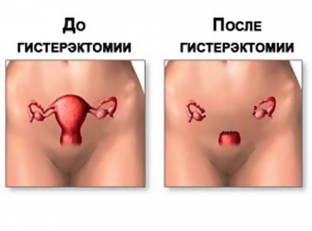Hysterectomy - a surgical operation to remove the uterus from a woman's body, is a fairly common operation today. There are quite a few gynecological pathologies, in which the removal of the uterus is the only effective method of treatment. But since this operation is radical and very traumatic for the woman's body, post-hysterectomy syndrome often occurs after it - a set of characteristic symptoms that occur after hysterectomy. What are the most characteristic symptoms after a hysterectomy that will indicate the development of post-hysterectomy syndrome - says estet-portal.com.
What post-hysterectomy symptoms include post-hysterectomy syndrome
One in five women over the age of 40 will have a hysterectomy. Removal of the uterus is a necessary treatment for diseases such as symptomatic uterine fibroids, prolapse or prolapse of this organ of the female reproductive system, malignant and some benign formations of the internal genital organs, pathological changes in the endometrium or chronic pelvic pain. A hysterectomy often has a negative impact on the quality of life and health of a woman, as in many cases there are unpleasant symptoms after a hysterectomy that affect all aspects of a woman's life.
Symptoms after hysterectomy:
- pathogenetic mechanisms of development of posthysterectomy syndrome;
- factors affecting the frequency of symptoms after hysterectomy;
- fundamentally significant classifications of posthysterectomy syndrome;
- clinical picture: what symptoms occur after hysterectomy.
Pathogenetic mechanisms of development of posthysterectomy syndrome
Pathogenetic mechanisms of development of posthysterectomy syndrome are quite simple and understandable. After hysterectomy, as a result of the exclusion of the branches of the uterine arteries from the blood circulation of the uterine appendages, microcirculation disorders and acute ovarian ischemia develop. In the ovaries, venous congestion and lymphostasis increase, as a result of which their structure changes and their volume increases. On this basis, steroidogenesis changes, which is primarily manifested by a decrease in E2. Ovarian ischemia stimulates degenerative and atrophic processes in them, which leads to the extinction of their ovulatory and hormone-producing functions. Hypoestrogenism occurs, on the basis of which the biosynthesis of neurotransmitters in the central nervous system decreases, which causes the appearance of characteristic symptoms after hysterectomy.
Factors affecting the frequency of symptoms after hysterectomy
Not every patient who has had a hysterectomy will experience the characteristic symptoms after a hysterectomy. There are such main factors affecting the incidence of post-hysterectomy syndrome:
- after hysterectomy, posthysterectomy syndrome occurs 1.7 times more often than after supravaginal amputation;
- when the uterus is removed along with one of the ovaries, symptoms after a hysterectomy develop 2.3 times more often than after the preservation of both ovaries during a hysterectomy;
- post-hysterectomy syndrome occurs 2 times more often when performing a hysterectomy in the luteal phase of the menstrual cycle;
- More often symptoms after hysterectomy occur in women operated between the ages of 41 and 55 than in patients of reproductive age;
- patients with diabetes mellitus and thyrotoxic goiter are also more likely to experience posthysterectomy syndrome than somatically healthy women.

Principally significant classifications of posthysterectomy syndrome
There are two fundamentally significant classifications of posthysterectomy syndrome: according to the time of onset and according to the clinical course of the disease. According to the time of occurrence, they are distinguished:
- early post-hysterectomy syndrome - the first symptoms after hysterectomy occur from the first day of the postoperative period;
- late post-hysterectomy syndrome develops between one month and one year after hysterectomy.
Depending on the clinical course, there are:
- transient posthysterectomy syndrome - characterized by the restoration of ovarian function within 1 month - 1 year after surgery, observed in 80% of patients aged 37 to 47 years;
- Persistent post-hysterectomy syndrome is characterized by the presence of hypoestrogenia for more than one year after hysterectomy, occurs in 20% of patients, most often between the ages of 46 and 52 years.
Clinical picture: what symptoms occur after hysterectomy
The clinical picture of post-hysterectomy syndrome is characterized by the development, mainly, of psycho-emotional and vegeto-neurotic disorders. As a manifestation of mental disorders, most patients experience a depressive state after hysterectomy with complaints of fatigue, weakness, lethargy, bad mood, decreased ability to work, and so on. Much less often, patients have an anxiety state with an unreasonable fear of sudden death. Quite often, patients complain about the fear of family breakdown due to a decrease in their own sexuality, on the basis of which libido suppression and a deterioration in the quality of a woman's sexual life may occur. Vegetoneurotic disorders after hysterectomy are manifested by the following symptoms:
- palpitations;
- chills and chilliness;
- crawling sensations on the skin;
- poor tolerance to high temperatures;
- hot flashes;
- excessive sweating;
- sleep disorders;
- edema;
- transient hypertension.






Add a comment